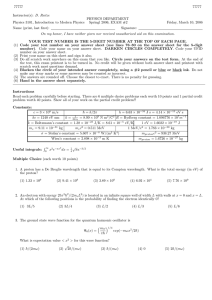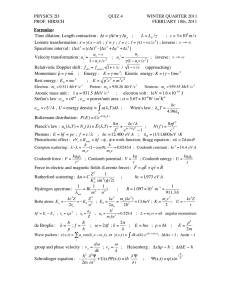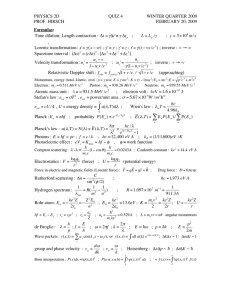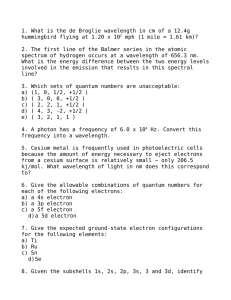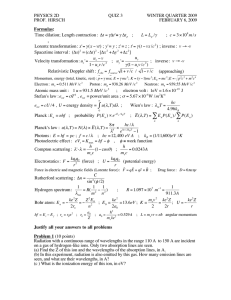PHYSICS 2D QUIZ 3 WINTER QUARTER 2016 PROF. HIRSCH
advertisement
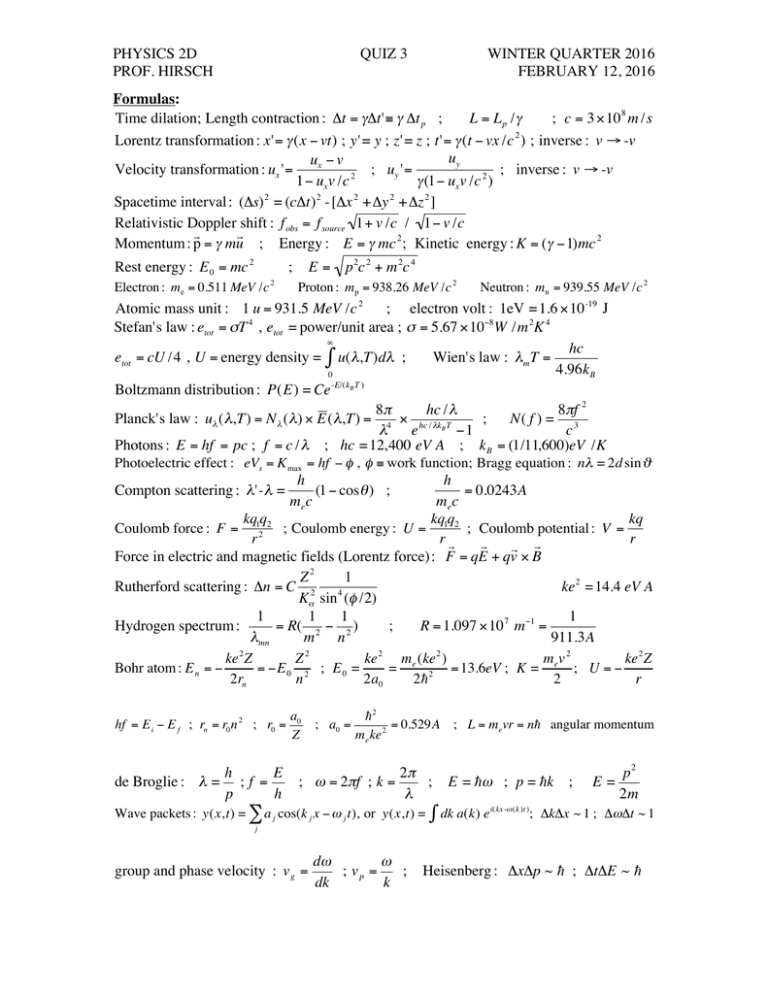
PHYSICS 2D PROF. HIRSCH € € € € € € € € € € € € € € € € € € € QUIZ 3 Formulas: Time dilation; Length contraction : Δt = γΔt'≡ γ Δt p ; L = Lp /γ ; c = 3 ×10 8 m /s Lorentz transformation : x'= γ (x − vt) ; y' = y ; z' = z ; t'= γ (t − vx /c 2 ) ; inverse : v → -v uy ux − v Velocity transformation : ux '= ; uy '= ; inverse : v → -v 2 γ (1− ux v /c 2 ) 1− ux v /c Spacetime interval : (Δs) 2 = (cΔt) 2 - [Δx 2 + Δy 2 + Δz 2 ] Relativistic Doppler shift : f obs = f source 1+ v /c / 1− v /c r r Momentum : p = γ mu ; Energy : E = γ mc 2 ; Kinetic energy : K = (γ −1)mc 2 Rest energy : E 0 = mc 2 ; Electron : me = 0.511 MeV /c 2 E= p 2c 2 + m 2c 4 Proton : mp = 938.26 MeV /c 2 Neutron : mn = 939.55 MeV /c 2 Atomic mass unit : 1 u = 931.5 MeV /c 2 ; electron volt : 1eV = 1.6 ×10 -19 J 4 Stefan's law : etot = σT , etot = power/unit area ; σ = 5.67 ×10−8 W /m 2K 4 ∞ hc etot = cU /4 , U = energy density = ∫ u( λ,T)dλ ; Wien's law : λm T = 4.96kB 0 -E/(kB T ) Boltzmann distribution : P(E) = Ce 8π hc / λ 8πf 2 Planck's law : uλ ( λ,T) = N λ ( λ) × E ( λ,T) = 4 × hc / λkB T ; N( f ) = 3 λ e −1 c Photons : E = hf = pc ; f = c / λ ; hc = 12,400 eV A ; k B = (1/11,600)eV /K Photoelectric effect : eVs = K max = hf − φ , φ ≡ work function; Bragg equation : nλ = 2d sin ϑ Compton scattering : λ'- λ = h (1 − cos θ ) ; mec h = 0.0243A mec kq q kq kq q Coulomb force : F = 12 2 ; Coulomb energy : U = 1 2 ; Coulomb potential : V = r r rr r r r Force in electric and magnetic fields (Lorentz force): F = qE + qv × B 1 Z2 ke 2 = 14.4 eV A Rutherford scattering : Δn = C 2 4 Kα sin (φ /2) 1 1 1 1 Hydrogen spectrum : = R( 2 − 2 ) ; R = 1.097 ×10 7 m−1 = λmn m n 911.3A 2 2 2 2 Z ke Z ke me (ke ) mev 2 ke 2 Z Bohr atom : E n = − = −E 0 2 ; E 0 = = = 13.6eV ; K = ; U =− n 2a0 2 2rn 2h 2 r hf = E i − E f ; rn = r0 n 2 ; r0 = a0 Z € € € WINTER QUARTER 2016 FEBRUARY 12, 2016 de Broglie : λ = h E ;f = p h ; a0 = h2 = 0.529A ; L = me vr = nh angular momentum me ke 2 ; ω = 2πf ; k = 2π ; λ Wave packets : y(x,t) = ∑ a j cos(k j x − ω j t), or y(x,t) = E = hω ; p = hk ; ∫ dk a(k) e i(kx -ω (k )t ) E= p2 2m ; ΔkΔx ~ 1 ; ΔωΔt ~ 1 j € € € group and phase velocity : v g = dω ω ; vp = ; dk k Heisenberg : ΔxΔp ~ h ; ΔtΔE ~ h PHYSICS 2D PROF. HIRSCH QUIZ 3 WINTER QUARTER 2016 FEBRUARY 12, 2016 Problem 1 An electron in hydrogen is initially in a Bohr orbit of radius 121a0 (a0=0.529A). What is the longest wavelength photon it can emit? A: 850,000A; B: 525,000A; C: 175,000A; D: 35,000A; E: not sure Problem 2 The electron in the ground state of a hydrogen atom is moving at a speed twice as fast as the electron in the state n of the He+ ion, where A: n=2; B; n=3; C: n=4; D: n=8; E: not sure (E always counts 0.31 points) Problem 3 Radiation of wavelengths in the range 1000A to 1050A is incident on a gas of hydrogen atoms where the electrons are initially in the ground state. Photons are absorbed and subsequently emitted. The longest wavelength photon emitted has wavelength approximately A: 18,746A; B: 4340A; C: 1215A; D: 6560A; E: not sure Problem 4 For the case of problem 3, the second longest wavelength photon emitted has wavelength A: 1215A; B: 1025A; C: 2075A; D: 4340A; E: not sure Problem 5 What is approximately the de Broglie wavelength for an electron in the n=3 orbit of the hydrogen atom? (A=Angstrom) A: 6A ; B: 8A; C: 10A; D: 12A; E: not sure Problem 6 An electron has de Broglie wavelength 0.6135A. Its kinetic energy is approximately A: 100eV; B: 200eV; C: 300eV; D: 400eV; E: not sure Problem 7 A wavepacket is formed by superposition of two waves with wavenumbers k1=1A-1, k2=1.1A-1 that have frequencies w1=2s-1, w2=2.4s-1. The ratio of group velocity to phase velocity is approximately A: 2; B: 1 ; C: 1/2 ; D: impossible to say; E: not sure Problem 8 An electron in a box of size L has kinetic energy 1000eV. L cannot be smaller than: (give the largest possible answer) A: 1A; B: 0.1A; C: 0.01A; D: 0,001A; E: not sure
